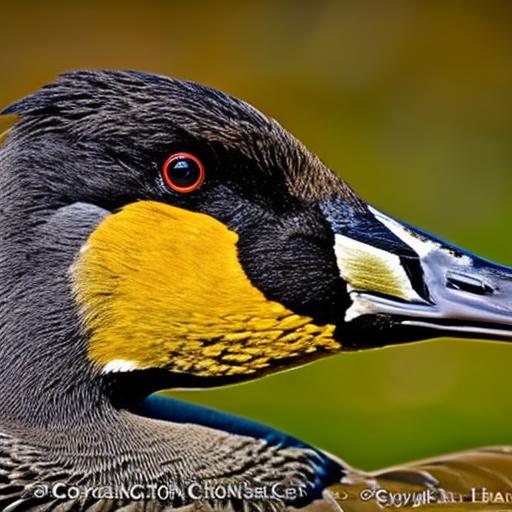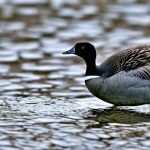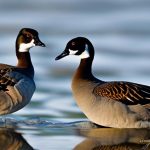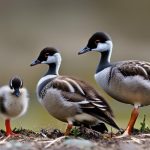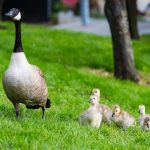Canada Geese, scientifically known as Branta canadensis, are large waterfowl native to North America. They are easily recognizable by their black heads and necks, white chinstrap, and brownish-gray bodies. These majestic birds are known for their distinctive honking calls and V-shaped flying formations during migration. Canada Geese are highly adaptable and can be found in a variety of habitats, including lakes, rivers, marshes, and grasslands. They are herbivores, feeding on a diet of grasses, grains, and aquatic plants. Canada Geese are monogamous and form strong pair bonds, often mating for life. They are also highly territorial during the breeding season, fiercely defending their nesting sites from intruders.
The Mating Ritual of Canada Geese
The mating ritual of Canada Geese is a fascinating display of courtship and bonding between pairs. It typically begins in late winter or early spring when the geese return to their breeding grounds. Male geese will perform elaborate displays to attract a mate, including honking loudly, stretching their necks, and flapping their wings. Once a pair bond is formed, the male and female will engage in mutual preening and head bobbing as a sign of affection. The pair will then begin to build their nest together, often in a secluded spot near water. The mating ritual of Canada Geese is a beautiful and intricate process that showcases the strong bond between mates and their dedication to starting a family.
Nesting and Egg-laying
After the mating ritual, Canada Geese will begin the process of nesting and egg-laying. The female will lay a clutch of eggs, typically ranging from 3 to 8 eggs, depending on the age and health of the female. The eggs are large and creamy white in color, with a slightly rough texture. The female will carefully arrange the eggs in the nest, covering them with down feathers for insulation and protection. The male will stand guard nearby, keeping a watchful eye for any potential threats. The nesting period is a critical time for Canada Geese, as they are vulnerable to predators and disturbances. It is essential for the nesting site to be undisturbed to ensure the successful hatching of the eggs.
Incubation and Hatching
Once the eggs are laid, the female Canada Goose will begin the process of incubation, sitting on the eggs to keep them warm and safe. The incubation period typically lasts around 25-28 days, during which the female will rarely leave the nest, relying on the male to bring her food. Incubation is a crucial stage in the breeding process, as the eggs must be kept at a consistent temperature for proper development. The male will continue to stand guard and defend the nesting site, ensuring the safety of the eggs and the female. As the incubation period nears its end, the eggs will begin to hatch, and the young goslings will emerge from their shells. This is an exciting and joyous moment for the parents, as they welcome their new offspring into the world.
Parental Care and Protection
Once the goslings have hatched, the parents will provide them with constant care and protection. The goslings are precocial, meaning they are born with their eyes open and are able to walk and swim shortly after hatching. The parents will lead their young to water, where they will learn to forage for food and swim under the watchful eye of their parents. Canada Geese are highly devoted parents, fiercely defending their goslings from predators and other threats. The parents will also teach their young important survival skills, such as how to find food and avoid danger. The bond between parents and offspring is strong, and the family unit will remain together until the goslings are old enough to fend for themselves.
Challenges and Threats During Breeding Season
Breeding season is a challenging time for Canada Geese, as they face a variety of threats and obstacles. One of the biggest challenges is finding suitable nesting sites, as human development and habitat destruction have greatly reduced the availability of natural nesting areas. Canada Geese often adapt to urban and suburban environments, nesting in parks, golf courses, and other man-made landscapes. However, this can lead to conflicts with humans and increased exposure to predators. Predation is another significant threat during breeding season, as eggs and goslings are vulnerable to a variety of predators, including raccoons, foxes, and birds of prey. Additionally, disturbances from human activities, such as boating, fishing, and recreational activities, can disrupt nesting and lead to abandonment of eggs or goslings.
Migration Patterns and Breeding Grounds
Canada Geese are known for their impressive migration patterns, traveling thousands of miles between their breeding and wintering grounds. In the spring, Canada Geese will migrate north to their breeding grounds, where they will establish nesting sites and raise their young. These breeding grounds are typically located in northern regions with abundant water and food resources. After the breeding season, Canada Geese will migrate south to their wintering grounds, where they will spend the colder months feeding and resting. Wintering grounds can vary from coastal areas to inland lakes and wetlands, providing the geese with a diverse range of habitats. Migration is a critical aspect of the Canada Geese life cycle, allowing them to take advantage of seasonal resources and avoid harsh weather conditions.
Impact of Human Interaction on Canada Geese Breeding
Human interaction can have a significant impact on Canada Geese breeding and nesting success. Urban and suburban development has encroached on natural habitats, forcing Canada Geese to adapt to human-altered landscapes. While this can provide the geese with access to food and water, it also exposes them to a variety of human-related threats, such as pollution, habitat destruction, and disturbances. Human activities, such as boating, fishing, and recreational use of waterways, can disrupt nesting and lead to abandonment of eggs or goslings. Additionally, conflicts with humans over nesting sites and aggressive behavior by geese can lead to negative perceptions and management efforts to control populations. It is essential for humans to be mindful of their impact on Canada Geese breeding and take steps to minimize disturbances and protect nesting sites.
Conservation Efforts and Management of Canada Geese Population
Conservation efforts and management of Canada Geese populations are essential for ensuring the long-term survival of these iconic birds. Many organizations and government agencies work to monitor and protect Canada Geese breeding grounds, implementing measures to reduce disturbances and mitigate human-wildlife conflicts. Habitat restoration and creation of nesting sites are critical for providing Canada Geese with suitable breeding areas. Additionally, public education and outreach programs can help raise awareness about the importance of protecting Canada Geese and their habitats. Population management strategies, such as egg oiling and relocation of problem geese, can help control populations in urban and suburban areas. It is crucial for conservation efforts to be collaborative and science-based, taking into account the needs of both Canada Geese and human communities.
The Future of Canada Geese Breeding and Conservation
The future of Canada Geese breeding and conservation is dependent on the collective efforts of individuals, organizations, and government agencies. As human populations continue to grow and urbanize, it is essential to prioritize the protection of natural habitats and wildlife corridors for Canada Geese. Conservation efforts should focus on creating and maintaining suitable nesting sites, reducing disturbances, and addressing human-wildlife conflicts in a sustainable and ethical manner. Research and monitoring of Canada Geese populations can provide valuable insights into their behavior and ecology, informing conservation strategies and management decisions. By working together to protect Canada Geese and their habitats, we can ensure that future generations will have the opportunity to witness the beauty and resilience of these remarkable birds.
Meet Walter, the feathered-friend fanatic of Florida! Nestled in the sunshine state, Walter struts through life with his feathered companions, clucking his way to happiness. With a coop that’s fancier than a five-star hotel, he’s the Don Juan of the chicken world. When he’s not teaching his hens to do the cha-cha, you’ll find him in a heated debate with his prized rooster, Sir Clucks-a-Lot. Walter’s poultry passion is no yolk; he’s the sunny-side-up guy you never knew you needed in your flock of friends!

